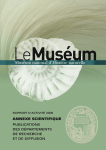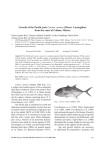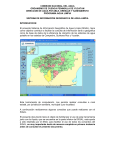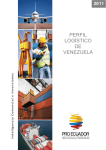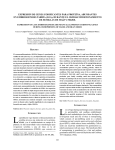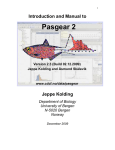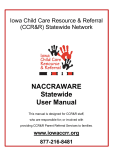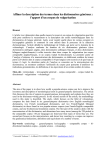Download Perciformes: Gerreidae
Transcript
Growth of the Shortnose Mojarra Diapterus brevirostris (Perciformes: Gerreidae) in Central Mexican Pacific Crecimiento de la malacapa Diapterus brevirostris (Perciformes: Gerreidae) en el Pacífico centro mexicano Manuel Gallardo-Cabello,1 Elaine Espino-Barr,2* Esther Guadalupe Cabral-Solís,2 Arturo García-Boa2 y Marcos Puente-Gómez2 1 Instituto de Ciencias del Mar y Limnología Universidad Nacional Autónoma de México Av. Ciudad Universitaria 3000, Col. Copilco México, D. F. (C. P. 04360). 2 INAPESCA, CRIP-Manzanillo Playa Ventanas s/n Manzanillo, Colima (C.P. 28200). Tel: (314) 332 3750 *Corresponding author: [email protected] Abstract Resumen Samples of Shortnose Mojarra Diapterus brevirostris were obtained from the commercial catch from April 2010 to July 2012, morphometric data of 394 individuals were registered. The growth study entailed two methods: length frequency analysis and study of sagittae and asterisci otoliths. Both methods identified six age groups. Growth parameters of von Bertalanffy’s equation were determined by Ford-Walford and Gulland methods and by ELEFAN routine adjustment. Both methods gave the same results: L∞= 48.61 cm, K= 0.135, to= -0.696. Mean size for each age was: age 1= 9.97 cm, age 2= 14.86 cm, age 3= 19.13 cm, age 4= 22.87 cm, age 5= 26.12 cm and age 6= 28.97 cm. The allometric index from the weight-length relationship was isometric and b= 2.977, the longevity was of 21.5 years. The growth ring is Se obtuvieron muestras y datos morfométricos de 394 individuos de la malacapa Diapterus brevirostris, de la captura comercial entre abril de 2010 y julio de 2012. El estudio del crecimiento se realizó por dos métodos: análisis de frecuencia de longitud y el estudio de los otolitos sagittae y asteriscus. Ambos métodos identificaron seis grupos de edad. Los parámetros de crecimiento de la ecuación de von Bertalanffy se determinaron con el método de FordWalford y Gulland y por rutina ELEFAN. Ambos métodos dieron los mismos resultados: L∞= 48.61 cm, K= 0.135, to= -0.696. La longitud media para cada edad fue: edad 1= 9.97 cm; edad 2= 14.86 cm; edad 3= 19.13 cm; edad 4= 22.87 cm; edad 5= 26.12 cm y edad 6= 28.97 cm. El índice alométrico de la relación longitud-peso fue isométrico y b= Avances en Investigación Agropecuaria • Gallardo-Cabello et al. Aia. 2014. 18(2): 27-40 Issn 0188789-0 27 Growth of the Shortnose Mojarra Diapterus brevirostris... marked because of the metabolic changes in the fish together with its response to environmental factors. The use of the growth parameters obtained by different methods is a robust result in the use of fishery models. Keywords Otoliths, length frequency distribution, von Bertalanffy, growth equation, growth in weight, longevity. S 2.977; la longevidad fue de 21.5 años. El anillo de crecimiento se marca por cambios en el metabolismo del pez, junto con su respuesta a los cambios ambientales. El uso de los parámetros de crecimiento obtenidos por diferentes métodos es un resultado robusto para la aplicación de modelos de pesquerías. Palabras clave Otolitos, distribución de frecuencia de longitud, von Bertalanffy, ecuación de crecimiento, crecimiento en peso, longevidad. Introduction hortnose Mojarra Diapterus brevirostris (Sauvage, 1879) used to be named Peruvian Mojarra D. peruvianus (Cuvier, 1830) (González-Acosta et al., 2007). Its common name, Peruvian Mojarra has also been changed for Shortnose Mojarra (pers. com. Héctor Espinosa-Pérez). It is distributed in the Eastern Pacific from southern part of the Gulf of California to Peru. Its habitat is near shore on sandy bottoms. Juveniles penetrate brackish coastal lagoons. The species is mainly carnivorous; it consumes small benthonic invertebrates and fish, also small amounts of algae matter (Castro-Aguirre, 1978; Allen and Robertson, 1994; Bussing, 1995; Castro-Aguirre et al., 1999). This species is an important fishery resource, caught by gill nets and cast nets by artisanal fishers, although it is not the target species. During 2011 the production in México of this resource was 62 thousand tons; the fishery in the Pacific coast contributes with 62% of the total catch, and Colima registered 345 t (1% of the Pacific production according to SAGARPA, 2011). The price at the market is of $30.00 Mexican pesos ($2.30 US dollar, exchange rate in 2012). Although the Shortnose Mojarra is a commercially important species, studies on its biology and population dynamics are limited; growth patterns were analyzed by geometric morphometrics by Vergara-Solana et al. (2013), weight-length relationships were reported by González-Acosta et al. (2004) and de la Cruz-Agüero et al. (2011). Age and growth studies of this species were only carried out by Cabrera-Peña et al. (1996) in Costa Rica coasts. Therefore, this investigation provides data on age and growth of D. brevirostris in Mexico, analyzing length-frequency data and otoliths (for the first time). Also, the otolith asterisci analysis has never been done on this species. These results are important in terms of the fish community, ecology, and biology; also they can be used in fishery models and capture quotas that will help assess and manage the fishery resource (Espino-Barr et al., 1998, 2013; Cabral-Solís et al., 2010). The aim of this paper was: 1) to analyze Diapterus brevirostris length frequency histograms, 2) to determine time of growth ring formation in sagittae and asterisci, and analyze minima and maxima growth, 3) to calculate von Bertalanffy’s growth constants parameters 28 • Avances en Investigación Agropecuaria Gallardo-Cabello et al. Aia. 2014. 18(2): 27-40 Issn 0188789-0 Revista de investigación y difusión científica agropecuaria by length frequency analysis data and ring identification in otoliths sagittae and asterisci, 4) to obtain the weight–length relationships (total and eviscerated weight), and asymptotic values of weight, 5) to estimate the longevity of D. brevirostris, and 6) to compare results obtained in the present study with those obtained by other authors in other places. Materials and methods From April 2010 to July 2012, individuals of D. brevirostris were obtained monthly from the commercial captures from Cuyutlán lagoon in Colima, México (19°00’ to 19°02’N and 104°10’ to 104°21’W) and in Tomatlán, Jalisco, Mexico (19°58’ to 20°04’N and 105°26’ to 105°32’W). Samples were identified using identification keys for the family (Castro-Aguirre, 1978; Bussing, 1995; Castro-Aguirre et al., 1999; González-Acosta et al., 2007). Total length (TL, cm) and weight (TW, g) of 1,886 individuals were measured. Of these, 394 were transported to the fish laboratory of the Instituto Nacional de Pesca, where total (TL, cm), standard length (SL, cm), height or body depth (D, cm) measured at the base of the dorsal fin were taken, total (TW, g) and eviscerated weight (EW, g) were registered and sex was observed macroscopically for each specimen. These individuals were captured with gillnets of different sizes (2.5-3.5 inch), which resulted in the capture of a diversity of different length sizes and age groups. To compare the relation and morphometric differences between males and females, a one way variance analysis (ANOVA) was carried out (Zar, 1996). The length frequency distribution was analyzed with the ELEFAN program of the FISAT package (Gayanilo et al., 1994; Sparre and Venema, 1995) to obtain the average length of corresponding to each age group. This method uses a goodness of fit index called Rn on a response surface, where the maximum value indicates the best combination of growth parameters. The time of the growth ring formation was determined, observing whether the borders had slow or fast growth rings. In every case, otoliths were observed by transparency with transmitted light (Gallardo-Cabello et al., in press); the hyaline (translucent) zone corresponds to the slow growth band and the opaque zone to the fast growth band, which is in contrast with reflected light (Blacker, 1974). The average length of each growth ring determined by the analysis of the sagittae and asterisci otoliths by Gallardo-Cabello et al. (in press) was used to obtain the parameters of von Bertalanffy´s (1938) growth equation. These observed values, translated to fish length were: for age 1 = 10.00 cm, age 2 = 15.00 cm, age 3 = 19.00cm, age 4 = 23.00 cm, age 5 = 26.00 cm and age 6 = 29.00 cm. Von Bertalanffy’s equation (1938) in the form of L = L∞ [1-e –K(t-to)], was used, where L = length, L∞ = asymptotic length, K = growth factor and to = theoretic length at age 0. The parameters L∞, K and to of von Bertalanffy´s (1938) equation were obtained with Ford´s (1933), Walford´s (1946) and Gulland´s method (1964) and were adjusted by convergent iterations with Newton´s algorithm in the solver program of Excel software (Microsoft, 1992). The lowest value of a sum of the squared error determined the best adjustment. Avances en Investigación Agropecuaria • Gallardo-Cabello et al. Aia. 2014. 18(2): 27-40 Issn 0188789-0 29 Growth of the Shortnose Mojarra Diapterus brevirostris... The function W = a·L b was used, where W = weight, L = length, to obtain the weight-length relationship, and a t- student test indicated allometry (Zar, 1996). The same function was also used to describe TL vs SL and D relationships, where the regression coefficient or slope b tends to 1, describing an isometric growth with those variables. Growth data for length- and weight-length relationships were used to obtain the weight at each age. Weight growth was obtained by substituting TL and L∞ by TW and W∞, in the von Bertalanffy´s equation (1938). Taylor´s equation (1958, 1960) was used to calculate the age limit or longevity (95% of the L∞): A0.95 = ln (1-0.95) / K + to. To compare the growth parameters of von Bertalanffy’s equation obtained in this study with those from other authors, growth performance index or phi prima test was estimated (Pauly, 1979): (phi’) ϕ’ = log K + 2∙log L∞. Results Sample. From April 2010 to July 2012, 394 organisms of Shortnose Mojarra Diapterus brevirostris were sampled in the Cuyutlán Lagoon, Manzanillo, Colima (México). Most of these organisms were young individuals and their sex was undetermined (284 individuals); of the samples that could be sexed, 64 were females and 46 were males. Biometric relationships. The maximum value of TL was 28.6 cm and the minimum was 9.1 cm, with a difference of 19.5 cm (Table 1). Total weight varied from 19.9. g to 362.6 g. Mode was higher than average, in the length cases, that is, in total (TL), standard (SL) and height (D) lengths of the body, implying a data distribution with positive asymmetric trend, also with more values higher than the mode. In the case of weight, the modes are lower than the averages. Age validation. The sampled organisms were used to calculate values of each age (Gallardo-Cabello et al., in press): for age 1 = 10.00 cm, age 2 = 15.00 cm, age 3 = 19.00cm, age 4 = 23.00 cm, age 5 = 26.00 cm and age 6 = 29.00 cm. These results are further analyzed in this study. Table 1 Summary of size values of the measured variables from Diapterus brevirostris. TL (cm) SL (cm) D (cm) TW (g) EW (g) Average 14.8 10.6 5.5 46.1 42.0 Maximum 28.6 21.0 10.6 362.6 310.4 Minimum 9.1 4.7 3.8 19.9 18.5 15.0 11.0 6.0 34.6 32.7 1.9 1.4 0.8 26.0 22.9 Mode SD n 394 TL = total length, SL=standard length, D=height or body depth, TW=total weight and EW=eviscerated weight. 30 • Avances en Investigación Agropecuaria Gallardo-Cabello et al. Aia. 2014. 18(2): 27-40 Issn 0188789-0 Revista de investigación y difusión científica agropecuaria Data of the relationships between length, maximum height and weight were highly significant, with r2 > 0.85 (P < 0.05) (Table 2). There were no statistical difference between sexes with size data (P < 0.05), that is, between females and males (F’ 0.05 (2, 109 = 3.929) = 1.269). The slopes of the relationships between lengths (TL and SL) were not statistically different to one, but the slopes of the relationships between Lt and maximum height (He) were statistically different to one, positive allometric. Those between TL and TW and EW were isometric, not different to three. Table 2 Morphometric relationships of the variables from Diapterus brevirostris. Species Females Males a 0.701 0.667 0.687 b 1.009 1.029 1.019 r 0.932 0.973 0.984 F 5,337.0 2,275.9 2,791.8 a 0.265 0.290 0.182 b 1.125 1.081 1.256 r 0.892 0.948 0.961 F 3,230.1 1,132.2 1,071.5 a 0.014 0.010 0.012 b 2.977 3.104 3.060 r 0.931 0.977 0.951 F 5,291.4 2,614.7 852.2 a 0.014 0.011 0.010 b 2.962 3.037 3.063 r 0.925 0.958 0.952 F 4,811.0 1,407.1 869.5 n 394 64 46 TL vs SL 2 TL vs D 2 TL vs TW 2 TL vs EW 2 TL = total length, SL=standard length, D=height, TW=total weight and EW=eviscerated weight, a = Y intercept, b = regression coefficient or slope, r2 = coefficient of determination, F = statistic test. Figure 1 shows the scatter diagram of the relation weight-length, adjusted by the potential model, where the adjustments of data from females and males can’t be differentiated. Avances en Investigación Agropecuaria • Gallardo-Cabello et al. Aia. 2014. 18(2): 27-40 Issn 0188789-0 31 Growth of the Shortnose Mojarra Diapterus brevirostris... Figure 1 Observed data and weight-length relationship by potential model with data of Diapterus brevirostris. 350 Eviscerated Weight (g) 300 250 200 150 100 50 0 0 5 EW 10 15 20 Total lenght (cm) calc all 25 30 calc f 35 calc m Note: for the species calc all = all the organisms, calc f = females and calc m = males. Time of growth rings formation of the slow and fast growth bands. Diapterus brevirostris showed that a higher percentage of sagittae and asterisci otoliths with fast growth borders occur from September to February, while the highest percentage with slow growth bands otoliths in the borders were observed from March to August (n = 180) (Fig. 2). Figure 2 Monthly frequency of growth borders in Diapterus brevirostris sagittae. 100% 90% 80% Frequency 70% 60% 50% 40% 30% 20% 10% 0% Jan Feb Mar Apr May Jun Jul Aug Sep Oct Months Hyaline Opaque Hyaline = slow growth, Opaque = fast growth. 32 • Avances en Investigación Agropecuaria Gallardo-Cabello et al. Aia. 2014. 18(2): 27-40 Issn 0188789-0 Nov Dec Revista de investigación y difusión científica agropecuaria Analysis of length frequency. Observed values of TL ranged from 9.1 cm to 32.0 cm; May, June and December have the smallest individuals and June the largest (Fig. 3). The results of length at each age are shown in Table 3; these values are similar to those obtained by otoliths rings growth analysis. Observed TL for each age obtained with ELEFAN’s method showed lower values from ages one to three, and higher values for ages four to six. Growth parameters for TL were: L∞ = 49.45 cm, K = 0.140 years-1 and to = -0.492 (Rn = 307). The sum of square errors (SSE) between observed values from otoliths and data obtained by ELEFAN was SSE = 9.41. Figure 3 Length frequency and growth curve of Diapterus brevirostris by elefan method. Length (cm) 30 20 10 0 Jan Feb Mar Apr May Jun Jul Aug Sep Oct Nov Dec 2011 Analysis of otoliths. Analysis of the sagittae and asterisci otoliths allowed the identification of 6 age groups. Growth parameters obtained by Ford-Walford-Gulland method for TL were: L∞= 48.61 cm, K= 0.135 years-1, to = -0.696. Growth parameters obtained by solver iterative process did not give a better fit of the calculated equation obtained from the otoliths readings; the values of the constants of von Bertalanffy growth equation were the same as those obtained from the Ford-Walford-Gulland methods. Growth from one age to the next was 9.97 cm from age 0 to age 1, 4.89 cm from age 1 to age 2, 4.27 cm from ages 2 to 3, 3.73 cm from ages 3 to 4, 3.26 cm from ages 4 to 5, and 2.85 cm from ages 5 to 6. Figure 4 shows the growth curve of D. brevirostris according to von Bertalanffy’s method. Avances en Investigación Agropecuaria • Gallardo-Cabello et al. Aia. 2014. 18(2): 27-40 Issn 0188789-0 33 Growth of the Shortnose Mojarra Diapterus brevirostris... Figure 4 Von Bertalanffy’s growth curve in length for Diapterus brevirostris by Ford-Walford-Gulland (F-W-G) with otolith readings and by length frequency with elefan methods. 40 TL (F-W-G)= 48.61 [1-e -0.135(t+0.696)] 35 TL (ELEFAN)= 49.45 [1-e -0.140(t+0.492)] Total Lenght (cm) 30 25 20 15 10 5 0 0 2 4 Observed Age (years) F-W-G 6 8 X 10 ELEFAN The sum of square errors (SSE) between observed and calculated data by Ford-Walford and Gulland was SSE = 6.321. Growth in weight. The growth index value of the weight-length equation was isometric: b= 2.997 with total weight data and b = 2.962 with eviscerated specimens (Table 2). Theoretical growth in weight. Values of calculated TW and EW have a slow growth during the first years of age, starting at 13 g and 12 g (Table 3, Fig. 5). After age 3 there is an important increment in the growth rate. The calculated asymptotic total weight was Wt∞ = 1,507.9 g and the eviscerated asymptotic weight We∞ = 1,348.5 g. Longevity (Age A0.95). D. brevirostris reached 95% of its infinite length L∞ in 21.5 years. 34 • Avances en Investigación Agropecuaria Gallardo-Cabello et al. Aia. 2014. 18(2): 27-40 Issn 0188789-0 Revista de investigación y difusión científica agropecuaria Table 3 Observed and calculated values of total length (cm) and total (TW) and eviscerated (EW) weight (g) for each age group (years) of Diapterus brevirostris. ELEFAN F-W Solver L ∞ 49.45 48.61 48.61 K 0.140 0.135 0.135 t o -0.492 -0.696 -0.696 Age (years) Observed (c`m, sd) ELEFAN (cm) F-W (cm) Solver (cm) TW (g) EW (g) 1 10.00 (± 1.172) 9.32 9.97 9.97 13 12 2 15.00 (± 1.119) 14.56 14.86 14.86 44 40 3 19.00 (± 0.813) 19.12 19.13 19.13 94 85 4 23.00 (± 0.873) 23.08 22.87 22.87 160 144 5 26.00 26.53 26.12 26.12 237 214 6 29.00 29.52 28.97 28.97 323 291 7 32.12 31.46 31.46 413 372 8 34.39 33.63 33.63 503 453 9 36.36 35.52 35.52 593 533 Avances en Investigación Agropecuaria • Gallardo-Cabello et al. Aia. 2014. 18(2): 27-40 Issn 0188789-0 35 Growth of the Shortnose Mojarra Diapterus brevirostris... Figure 5 Von Bertalanffy’s growth curve in total and eviscerated weight for Diapterus brevirostris. 700 TW= 1,507.9 [1-e -0.135(t+0.696)]2.977 600 EW= 1,348.5 [1-e -0.135(t+0.696)]2.962 Weight (g) 500 400 300 200 100 0 0 2 4 6 Age (years) EW 8 10 TW Discussion Using commercial catch individuals for the growth study of this species can have been biased due to the different fishing gears used to fish. Nevertheless the sample had a large distribution of lengths and ages. The relationship between standard and total length showed an isometric growth. Data of the relationships between total length and height (Table 2) show a higher tendency to positive allometry. This tendency is even higher in males than females (and with all the individuals it was average, Table 2). In the case of the relationships between total weight and total length, an isometric growth is observed, for the species and for both sexes, that is, the organisms grow in the same proportion in weight than in length throughout their life cycle (Table 2). González-Acosta et al. (2004) report for this species a value of the alometric index of the weight-length relationship of b = 3.21 in the Gulf of California, México. Similarly, de la Cruz-Agüero et al. (2011) found a value of b = 3.21 (95% Confidence Interval from 3.18 to 3.24). Each year a band of fast and slow growth are deposited on the otoliths sagittae and asterisci, allowing the use of this structure to estimate age of D. brevirostris and its growth. This has also been found in other tropical species, where scales are not present (Gallardo-Cabello et al., 2006; 2007; 2011; Espino-Barr et al., 2006; 2008), allowing a good assessment of ageing, not always possible with scales. 36 • Avances en Investigación Agropecuaria Gallardo-Cabello et al. Aia. 2014. 18(2): 27-40 Issn 0188789-0 Revista de investigación y difusión científica agropecuaria The values obtained with the length frequency analysis were similar to those found by the identification of growth rings in the sagittae and asterisci, which render age determination of D. brevirostris valid with both methods, and validating each other (Joseph, 1962). The differences emerged are because of the methods used: a direct and an indirect approach. Related to the growth parameters calculations done by other authors, Cabrera-Peña et al. (1996) studied D. brevirostris in estuarine waters of two rivers: Damas and Palo Seco in Costa Rica and found a higher value of the index K = 0.26 (using Allen’s method) and K = 0.293 (applying Tomlinson and Abramson’s method) and therefore a low asymptotic length L∞ = 31.9 cm and L∞ = 32.3, respectively. Because of these K values, the species would reach L∞ faster and would have a maximum longevity of 11.1 years and 10.2 years, respectively. The differences found in the parameter values by Cabrera-Peña et al. (1996) for this species in Costa Rica (Table 4), are related with what Taylor (1958, 1960) considers, that is, the same species living in lower latitudes and higher temperatures will present higher values of the catabolic index K and will achieve smaller lengths of L∞, and therefore lower longevities. Table 4 Growth parameters of the von Bertalanffy equation for Diapterus brevirostris obtained by different authors (longevity and f’ values were calculated by us). This paper Cabrera-Peña et al. Cabrera-Peña et al. Year 2011 1996 1996 Area Colima, México Costa Rica Costa Rica Method otoliths Allen Tomlinson & Abramson L ∞ (cm) 48.61 31.9 32.3 K 0.135 0.268 0.293 t o -0.696 0.046 0.042 Longevity (years) 21.5 11.1 10.2 f’ 2.504 2.436 2.485 Besides, in the Atlantic ocean, in the Lagoon of Términos, Campeche, México, Ayala-Pérez et al. (2001) found values for Diapterus rhombeus of L. von Bertalanffy K = 0.74, L∞ = 20.4 cm and t0 = -4.207. The value of K is very high, therefore this organism will reach L∞ very fast, presenting longevity of four years. Ayala-Pérez et al. (2001) found in their study that 69.9% of individuals are juveniles therefore this analysis corresponds to the first part of the curve of von Bertalanffy and the catabolic index is higher than the real. Had these authors used organisms of a higher age, they would have found lower values of K and higher L∞. Avances en Investigación Agropecuaria • Gallardo-Cabello et al. Aia. 2014. 18(2): 27-40 Issn 0188789-0 37 Growth of the Shortnose Mojarra Diapterus brevirostris... Other studies show also a fast growth in the Gerreidae family during the first 3 years of age: K can range between K = 0.425 and 0.452 in females and males of Gerres equulus (Iqbal et al., 2006), K = 0.80 and 0.82 in females and males of Gerres sp. (Kanak and Tachihara, 2006), to K = 1.0 in Gerres oblongus (Shutharshan and Sivashanthini, 2011). In Gerres cinereus, it has been calculated a K = 0.34 (Álvarez-Hernández, 1999), K = 0.65 (Claro and García-Arteaga, 2001). Differences found in the values of the growth parameters of the von Bertalanffy equation are determined by the environmental conditions such as latitude, temperature, salinity, among other (Taylor, 1958; 1960). The pressure of the fishing activity has also an influence: if there is overfishing, the older age groups will disappear (Espino-Barr et al., 2010; Gallardo-Cabello et al., 2011). Conclusions This study shows the age and sex composition, growth index and longevity of the Shortnose Mojarra Diapterus brevirostris in the Mexican Central Pacific. This information, together with studies of reproduction will allow the management of the fishery by suggesting fishing gears such as size of the mesh opening, closed seasons to the fishing, catch quotas, which will avoid the overexploitation of the natural resources. The growth ring marked during the months of spring, and the calculated birthday, also calculated in this season are due to metabolic factor, as a result of the changes in the currents near the coast line of the central Mexican Pacific. The analysis of growth of the Shortnose Mojarra Diapterus brevirostris by several methods strengthens the calculated parameters, and assures the use of these results in the fisheries research. Acknowledgments We are thankful to the fishers who obtained the sample and always are willing to help and teach us their knowledge of the fish. Also, we are grateful to the anonymous reviewers who improved this study. Cited Literature Allen, G.R. and Robertson, D.R. (1994). Peces del Pacífico Oriental Tropical. CONABIO, Agrupación Sierra Madre y CEMEX. México. 327pp. Álvarez-Hernández, J. H. (1999). Edad y crecimiento de la mojarra Gerres cinereus en la costa sur del estado de Quintana Roo, México. Proc. Gulf Carrib. Fish. Inst. 45:514-523. Ayala-Pérez, L. A.; Gómez-Montes, B. A. and Ramos-Miranda, J. (2001). Distribución, abundancia y parámetros poblacionales de la mojarra, Diapterus rhombeus (Pisces: Gerreidae) en la Laguna de Términos, Campeche, México. Revista de Biología Tropical 49(2):635-642. Blacker, R. W. (1974). Recent advances in otolith studies. In: Harden-Jones, E. (Ed). Sea Fisheries Research. pp. 67-90. Elek Science, London. Bussing, W. A. (1995). Gerreidae, Mojarras. In: Fischer, W.; Krupp, F.; Schneides, W.; Sommer, C.; Carpenter, K. E. and Niem, U. H. Guía Fao para la identificación de especies para los fines de la pesca. Pacífico Centro Oriental. Vertebrados, Vols. II, Roma, FAO. Italia. p. 1114-1128. 38 • Avances en Investigación Agropecuaria Gallardo-Cabello et al. Aia. 2014. 18(2): 27-40 Issn 0188789-0 Revista de investigación y difusión científica agropecuaria Cabral-Solís, E.G.; Gallardo-Cabello, M.; Espino-Barr, E. and Ibáñez-Aguirre, A.L. (2010). Reproduction of Mugil curema (Pisces: Mugilidae) from the Cuyutlán lagoon, in the Pacific coast of México. Avances de Investigación Agropecuaria 14(3):19-32. Cabrera-Peña, J.; Solano-López, Y. and Mora-Hernández, M. (1996). Crecimiento de Diapterus peruvianus (Pisces: Gerreidae) en los estuarios de los ríos Damas y Palo Seco, Costa Rica. Revista de Biología Tropical 44(2):935-937. Castro-Aguirre, J. L. (1978). Catálogo sistemático de los peces marinos que penetran a las aguas continentales de México, con aspectos zoogeográficos y ecológicos. Depto. Pesca. INP. Serie Científica No. 19., 298 pp. Castro-Aguirre, J. L.; Espinosa-Pérez, H. S. y Schmitter-Soto, J. J. (1999). Ictiofauna estuarino-lagunar y vicaria de México. Serie Biotecnologías. IPN y Ed. Noriega-Limusa, 711 pp. Claro, R. and García-Arteaga, J. P. (2001). Growth Patterns of Fishes of the Cuban Shelf. In: Ecology of the Marine Fishes of Cuba. Claro, R.; Kindeman, K. C. and Parenti, L. R. (Eds.). Smithonian Institution Press, Washington, D. C., USA., pp: 149-178. De la Cruz-Agüero, J.; García-Rodríguez, F. J.; Cota-Gómez, V. M.; Chollet-Villalpando, J. G. and VergaraSolana, F. J. (2011). Length-weight relations of selected species of the family Gerreidae (Actinopterygii: Perciformes) from the Mexican coast. Acta Ichthyologica et Piscatoria 41(1): 67-69. Espino-Barr, E.; Gallardo-Cabello, M.; García-Boa, A.; Cabral-Solís, E. G. and Puente-Gómez, M. (2006). Morphologic and morphometric analysis and growth rings identification of otoliths: sagitta, asteriscus and lapillus of Caranx caninus (Pisces: Carangidae) in the coast of Colima, Mexico. Journal of Fisheries and Aquatic Science 1(2):157-170. Espino-Barr, E.; Cruz-Romero, M. y Garcia-Boa, A. (1998). Edad y crecimiento del huachinango Lutjanus peru (Nichols y Murphy, 1922), en la costa del estado de Colima, México. Avances de Investigación Agropecuaria 7(1):040-051. Espino-Barr, E.; Gallardo-Cabello, M.; Cabral Solís, E. G.; García-Boa, A. and Puente-Gómez, M. (2008). Growth of the Pacific jack Caranx caninus (Pisces: Carangidae) from the coast of Colima, México. Revista de Biología Tropical 56(1):171-179. Espino-Barr, E.; Gallardo-Cabello, M.; Granados-Flores, K.; Cabral-Solís, E. G.; García-Boa, A. and Puente-Gómez, M. (2010). Growth analysis of Microlepidotus brevipinnis from the Pacific coast of Jalisco, Mexico. Journal of Fisheries and Aquatic Science 5:293-303. Espino-Barr, E.; Gallardo-Cabello, M.; Cabral-Solís, E.G.; Puente-Gómez, M. and García-Boa, A. (2013). Otoliths analysis of Mugil curema (Pisces: Mugilidae) in Cuyutlan Lagoon, Mexico. Avances en Investigación Agropecuaria 17(1):35-64. Ford, E. (1933). An account of the herring investigations conducted at Plymouth during the years from 1924 to 1933. Journal of the Marine Biological Association of the United Kingdom 19:305-384. Gallardo-Cabello, M.; Espino-Barr, E.; García-Boa, A.; Cabral-Solís, E. G. and Puente-Gómez, M. (2006). Morphologic and morphometric analysis and growth rings identification of otoliths: sagitta, asteriscus and lapillus of Caranx caballus (Pisces: Carangidae) in the coast of Colima, Mexico. International Journal of Zoological Research 2(1):34-47. Gallardo-Cabello, M.; Espino-Barr, E.; García-Boa, A.; Cabral-Solís, E. G. and Puente-Gómez, M. (2007). Study of the growth of the green jack Caranx caballus Günther 1868, in the coast of Colima, Mexico. Journal of Fisheries and Aquatic Science 2(2):130-139. Gallardo-Cabello, M.; Espino-Barr, E.; Nava-Ortega, R. A.; García-Boa, A.; Cabral-Solís, E. G. and Puente-Gómez, M. (2011). Analysis of the otoliths of sagitta, asteriscus and lapillus of Pacific sierra Scomberomorus sierra (Pisces: Scombridae) in the coast of Colima, Mexico. Journal of Fisheries and Aquatic Science 6(4):390-403. Gallardo-Cabello, M.; Espino-Barr, E.; Cabral-Solís, E. G.; Puente-Gómez, M. and García-Boa, A. (in press). Study on the otoliths sagitta, asteriscus and lapillus of shortnose mojarra Diapterus brevirostris (Pisces: Gerreidae) in the Cuyutlan lagoon, Colima, México. Revista de Biología Marina y Oceanografía Gayanilo, F. C.; Sparre, P. and Pauly, D. (1994). The FAO-ICLARM Stock Assessment Tools (FiSAT) user´s guide. FAO Computarized Information Series Fisheries 6:1-186, FAO, Roma. Avances en Investigación Agropecuaria • Gallardo-Cabello et al. Aia. 2014. 18(2): 27-40 Issn 0188789-0 39 Growth of the Shortnose Mojarra Diapterus brevirostris... González-Acosta, A. F.; De la Cruz-Agüero, G. and De la Cruz-Agüero, J. (2004). Length-weight relationships of fish caught in a mangrove swamp in the Gulf of California (México). Journal of Applied Ichthyology 20:154-155. González-Acosta, A. F.; Béarez, P.; Álvarez-Pliego, N.; de la Cruz-Agüero, J. and Castro-Aguirre, J. L. (2007). On the taxonomic status of Diapterus peruvianus (Cuvier, 1830) and reinstatement of Diapterus brevirostris (Sauvae, 1879) (Teleostei: Gerreidae). Cybium 31(3):369-377. Gulland, J. A. (1964). Manual of methods of fish population analysis. FAO Fisheries Technical Paper 40:1-60. Iqbal, K-M.; Masuda, Y.; Suzuki, H. and Shinomiya, A. (2006). Age and growth of the Japanese Silverbiddy, Gerres equulus, in western Kyushu, Japan. Fisheries Research 77(1):45-52. Joseph, D. C. (1962). Growth characteristics of two Southern California Surffishes, the California corbina and spotfin croaker, Family Sciaenidae. The Resources Agency of California. Department of Fish and Game. Fishery Bulletin 119:1-54. Kanak, M. K. and Tachihara, K. (2006). Age and growth of Gerres sp. (Perciformes: Gerreidae) in Okinawa Island of Southern Japan. Fisheries Science 72:932-938. Microsoft. (1992). Manual de usuario. Referencia de funciones. Microsoft Excel Versión 4.0 para Windows, 702 pp. Microsoft Corporation USA, Redmond. Pauly, D. (1979). Theory and management of tropical multispecies stocks: a review with emphasis on the Southeast Asian demersal fisheries. ICLARM Studies Reviews 1:1-35. SAGARPA. (2011). Anuario estadístico de pesca 2009. Comisión Nacional de Acuacultura y Pesca, Secretaría de Agricultura, Ganadería, Desarrollo Rural, Pesca y Alimentación, 305 pp. (http://www. conapesca.sagarpa.gob.mx/wb/cona/anuario_2011). Shutharshan, S. and Sivashanthini, K. (2011). Growth characteristics of Slender Silver-biddies Gerres oblongus (Pisces: Perciformes) from the Jaffna Lagoon, Sri Lanka. Journal of Fisheries and Aquatic Sciences 6(6):592-603. Sparre, P. and Venema, S. C. (1995). Introducción a la evaluación de recursos pesqueros tropicales. Parte 1 - Manual. FAO Doc. Tec. de Pesca 306/1, Roma. Taylor, C. C. (1958). Cod growth and temperature. Journal du Conseil 23(3):366-370. Taylor, C. C. (1960). Temperature, growth and mortality – the Pacific cockle. Journal du Conseil 26(1):177124. Von Bertalanffy, L. (1938). A quantitative theory of organic growth (inquiries on growth laws. Human Biology 10(2):181-213. Vergara-Solana, F. J.; García-Rodríguez, F. J. and De la Cruz-Agüero, J. (2013). Interspecific comparison of growth and shape within Diapterus (Gerreidae: Perciformes) using geometric morphometrics. Journal of Ichthyology 53(6):445-454. Walford, L. A. (1946). A new graphic method of describing the growth of animals. The Biological Bulletin 90(2):141-147. Zar, J. H. (1996). Biostatistical analysis. 3rd edn. Prentice Hall. USA. 662 pp. Recibido: Octubre 04, 2013 Inicio de arbitraje: Octubre 17, 2013 Dictamen para autor: Diciembre 02, 2013 Aceptado: Abril 10, 2014 40 • Avances en Investigación Agropecuaria Gallardo-Cabello et al. Aia. 2014. 18(2): 27-40 Issn 0188789-0














